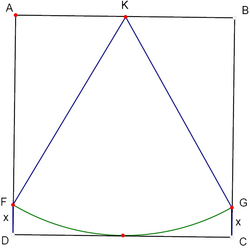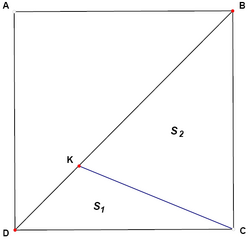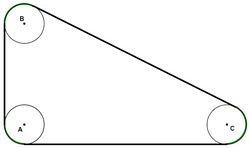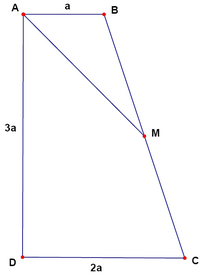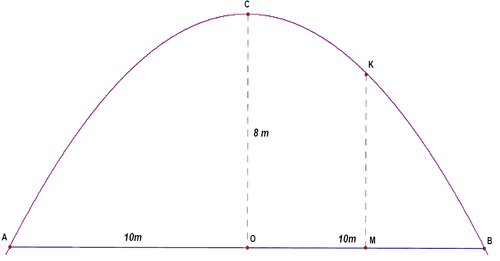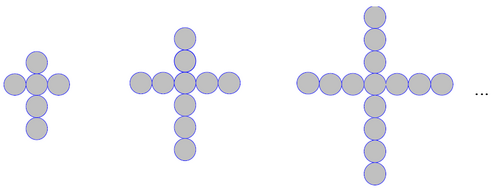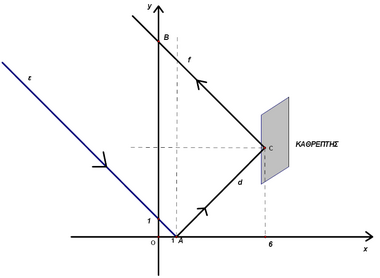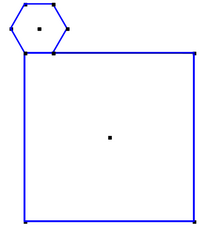Difference between revisions of "2007 Cyprus MO/Lyceum/Problems"
I_like_pie (talk | contribs) m (→Problem 22) |
(→Problem 16) |
||
| (5 intermediate revisions by 3 users not shown) | |||
| Line 2: | Line 2: | ||
If <math>x-y=1</math>, then the value of the expression <math>K=x^2+x-2xy+y^2-y</math> is | If <math>x-y=1</math>, then the value of the expression <math>K=x^2+x-2xy+y^2-y</math> is | ||
| − | + | <math>\mathrm{(A)}\ 2\qquad\mathrm{(B)}\ -2\qquad\mathrm{(C)}\ 1\qquad\mathrm{(D)}\ -1\qquad\mathrm{(E)}\ 0</math> | |
| − | |||
| − | B | ||
| − | |||
| − | C | ||
| − | |||
| − | D | ||
| − | |||
| − | E | ||
[[2007 Cyprus MO/Lyceum/Problem 1|Solution]] | [[2007 Cyprus MO/Lyceum/Problem 1|Solution]] | ||
| Line 17: | Line 9: | ||
Given the formula <math>f(x) = 4^x</math>, then <math>f(x+1)-f(x)</math> equals to | Given the formula <math>f(x) = 4^x</math>, then <math>f(x+1)-f(x)</math> equals to | ||
| − | + | <math>\mathrm{(A)}\ 4\qquad\mathrm{(B)}\ 4^x\qquad\mathrm{(C)}\ 2\cdot4^x\qquad\mathrm{(D)}\ 4^{x+1}\qquad\mathrm{(E)}\ 3\cdot4^x</math> | |
| − | |||
| − | B | ||
| − | |||
| − | C | ||
| − | |||
| − | D | ||
| − | |||
| − | E | ||
[[2007 Cyprus MO/Lyceum/Problem 2|Solution]] | [[2007 Cyprus MO/Lyceum/Problem 2|Solution]] | ||
| Line 32: | Line 16: | ||
A cyclist drives form town A to town B with velocity <math>40 {}^{km}/{}_h</math> and comes back with velocity <math> 60 {}^{km}/{}_h</math>. The mean velocity in <math>{}^{km}/{}_h</math> for the total distance is | A cyclist drives form town A to town B with velocity <math>40 {}^{km}/{}_h</math> and comes back with velocity <math> 60 {}^{km}/{}_h</math>. The mean velocity in <math>{}^{km}/{}_h</math> for the total distance is | ||
| − | + | <math>\mathrm{(A)}\ 45\qquad\mathrm{(B)}\ 48\qquad\mathrm{(C)}\ 50\qquad\mathrm{(D)}\ 55\qquad\mathrm{(E)}\ 100</math> | |
| − | |||
| − | B | ||
| − | |||
| − | C | ||
| − | |||
| − | D | ||
| − | |||
| − | E | ||
[[2007 Cyprus MO/Lyceum/Problem 3|Solution]] | [[2007 Cyprus MO/Lyceum/Problem 3|Solution]] | ||
| Line 49: | Line 25: | ||
The value of <math>(2*0)*1</math> is | The value of <math>(2*0)*1</math> is | ||
| − | + | <math>\mathrm{(A)}\ 2\qquad\mathrm{(B)}\ 1\qquad\mathrm{(C)}\ 0\qquad\mathrm{(D)}\ \frac{1}{2}\qquad\mathrm{(E)}\ \frac{5}{2}</math> | |
| − | |||
| − | B | ||
| − | |||
| − | C | ||
| − | |||
| − | D | ||
| − | |||
| − | E | ||
| − | |||
[[2007 Cyprus MO/Lyceum/Problem 4|Solution]] | [[2007 Cyprus MO/Lyceum/Problem 4|Solution]] | ||
| Line 65: | Line 32: | ||
If the remainder of the division of <math>a</math> with <math>35</math> is <math>23</math>, then the remainder of the division of <math>a</math> with <math>7</math> is | If the remainder of the division of <math>a</math> with <math>35</math> is <math>23</math>, then the remainder of the division of <math>a</math> with <math>7</math> is | ||
| − | + | <math>\mathrm{(A)}\ 1\qquad\mathrm{(B)}\ 2\qquad\mathrm{(C)}\ 3\qquad\mathrm{(D)}\ 4\qquad\mathrm{(E)}\ 5</math> | |
| − | |||
| − | B | ||
| − | |||
| − | C | ||
| − | |||
| − | D | ||
| − | |||
| − | E | ||
[[2007 Cyprus MO/Lyceum/Problem 5|Solution]] | [[2007 Cyprus MO/Lyceum/Problem 5|Solution]] | ||
== Problem 6 == | == Problem 6 == | ||
| − | + | [[Image:2007 CyMO-6.PNG|250px|right]] | |
| − | [[Image:2007 CyMO-6.PNG|250px]] | + | |
| − | |||
<math>ABCD</math> is a square of side length 2 and <math>FG</math> is an arc of the circle with centre the midpoint <math>K</math> of the side <math>AB</math> and radius 2. The length of the segments <math>FD=GC=x</math> is | <math>ABCD</math> is a square of side length 2 and <math>FG</math> is an arc of the circle with centre the midpoint <math>K</math> of the side <math>AB</math> and radius 2. The length of the segments <math>FD=GC=x</math> is | ||
| − | + | <math>\mathrm{(A)}\ \frac{1}{4}\qquad\mathrm{(B)}\ \frac{\sqrt{2}}{2}\qquad\mathrm{(C)}\ 2-\sqrt{3}\qquad\mathrm{(D)}\ \sqrt{3}-1\qquad\mathrm{(E)}\ \sqrt{2}-1</math> | |
| − | |||
| − | B | ||
| − | |||
| − | C | ||
| − | |||
| − | D | ||
| − | |||
| − | E | ||
| − | |||
[[2007 Cyprus MO/Lyceum/Problem 6|Solution]] | [[2007 Cyprus MO/Lyceum/Problem 6|Solution]] | ||
| Line 99: | Line 48: | ||
If a diagonal <math>d</math> of a rectangle forms a <math>60^\circ</math> angle with one of its sides, then the area of the rectangle is | If a diagonal <math>d</math> of a rectangle forms a <math>60^\circ</math> angle with one of its sides, then the area of the rectangle is | ||
| − | + | <math>\mathrm{(A)}\ \frac{d^2 \sqrt{3}}{4}\qquad\mathrm{(B)}\ \frac{d^2}{2}\qquad\mathrm{(C)}\ 2d^2\qquad\mathrm{(D)}\ d^2 \sqrt{2}\qquad\mathrm{(E)}\ \mathrm{None\ of\ these}</math> | |
| − | |||
| − | B | ||
| − | |||
| − | C | ||
| − | |||
| − | D | ||
| − | |||
| − | |||
[[2007 Cyprus MO/Lyceum/Problem 7|Solution]] | [[2007 Cyprus MO/Lyceum/Problem 7|Solution]] | ||
| Line 114: | Line 55: | ||
If we subtract from 2 the inverse number of <math>x-1</math>, we get the inverse of <math>x-1</math>. Then the number <math>x+1</math> equals to | If we subtract from 2 the inverse number of <math>x-1</math>, we get the inverse of <math>x-1</math>. Then the number <math>x+1</math> equals to | ||
| − | + | <math>\mathrm{(A)}\ 0\qquad\mathrm{(B)}\ 1\qquad\mathrm{(C)}\ -1\qquad\mathrm{(D)}\ 3\qquad\mathrm{(E)}\ \frac{1}{2}</math> | |
| − | |||
| − | B | ||
| − | |||
| − | C | ||
| − | |||
| − | D | ||
| − | |||
| − | E | ||
[[2007 Cyprus MO/Lyceum/Problem 8|Solution]] | [[2007 Cyprus MO/Lyceum/Problem 8|Solution]] | ||
| Line 129: | Line 62: | ||
We consider the sequence of real numbers <math>a_1,a_2,a_3,...</math> such that <math>a_1=0</math>, <math>a_2=1</math> and <math>a_n=a_{n-1}-a_{n-2}</math>, <math>\forall n \in \{3,4,5,6,...\}</math>. The value of the term <math>a_{138}</math> is | We consider the sequence of real numbers <math>a_1,a_2,a_3,...</math> such that <math>a_1=0</math>, <math>a_2=1</math> and <math>a_n=a_{n-1}-a_{n-2}</math>, <math>\forall n \in \{3,4,5,6,...\}</math>. The value of the term <math>a_{138}</math> is | ||
| − | + | <math>\mathrm{(A)}\ 0\qquad\mathrm{(B)}\ -1\qquad\mathrm{(C)}\ 1\qquad\mathrm{(D)}\ 2\qquad\mathrm{(E)}\ -2</math> | |
| − | |||
| − | B | ||
| − | |||
| − | C | ||
| − | |||
| − | D | ||
| − | |||
| − | E | ||
[[2007 Cyprus MO/Lyceum/Problem 9|Solution]] | [[2007 Cyprus MO/Lyceum/Problem 9|Solution]] | ||
| Line 144: | Line 69: | ||
The volume of an orthogonal parallelepiped is <math>132\;\mathrm{cm}^3 </math> and its dimensions are integers. The minimum sum of the dimensions is | The volume of an orthogonal parallelepiped is <math>132\;\mathrm{cm}^3 </math> and its dimensions are integers. The minimum sum of the dimensions is | ||
| − | + | <math>\mathrm{(A)}\ 27\ \mathrm{cm}\qquad\mathrm{(B)}\ 19\ \mathrm{cm}\qquad\mathrm{(C)}\ 20\ \mathrm{cm}\qquad\mathrm{(D)}\ 18\ \mathrm{cm}\qquad\mathrm{(E)}\ \mathrm{None\ of\ these}</math> | |
| − | |||
| − | B | ||
| − | |||
| − | C | ||
| − | |||
| − | D | ||
| − | |||
| − | |||
[[2007 Cyprus MO/Lyceum/Problem 10|Solution]] | [[2007 Cyprus MO/Lyceum/Problem 10|Solution]] | ||
| Line 159: | Line 76: | ||
If <math>X=\frac{1}{2007 \sqrt{2006}+2006 \sqrt{2007}}</math> and <math>Y=\frac{1}{\sqrt{2006}}-\frac{1}{\sqrt{2007}}</math>, which of the following is correct? | If <math>X=\frac{1}{2007 \sqrt{2006}+2006 \sqrt{2007}}</math> and <math>Y=\frac{1}{\sqrt{2006}}-\frac{1}{\sqrt{2007}}</math>, which of the following is correct? | ||
| − | + | <math>\mathrm{(A)}\ X=2Y\qquad\mathrm{(B)}\ Y=2X\qquad\mathrm{(C)}\ X=Y\qquad\mathrm{(D)}\ X=Y^2\qquad\mathrm{(E)}\ Y=X^2</math> | |
| − | |||
| − | B | ||
| − | |||
| − | C | ||
| − | |||
| − | D | ||
| − | |||
| − | E | ||
[[2007 Cyprus MO/Lyceum/Problem 11|Solution]] | [[2007 Cyprus MO/Lyceum/Problem 11|Solution]] | ||
| Line 174: | Line 83: | ||
The function <math>f : \Re \rightarrow \Re</math> has the properties <math>f(0) = -1</math> and <math>f(xy)+f(x)+f(y)=x+y+xy+k</math> <math>\forall x,y \in \Re</math>, where <math>k \in \Re</math> is a constant. The value of <math>f(-1)</math> is | The function <math>f : \Re \rightarrow \Re</math> has the properties <math>f(0) = -1</math> and <math>f(xy)+f(x)+f(y)=x+y+xy+k</math> <math>\forall x,y \in \Re</math>, where <math>k \in \Re</math> is a constant. The value of <math>f(-1)</math> is | ||
| − | + | <math>\mathrm{(A)}\ 1\qquad\mathrm{(B)}\ -1\qquad\mathrm{(C)}\ 0\qquad\mathrm{(D)}\ -2\qquad\mathrm{(E)}\ 3</math> | |
| − | |||
| − | B | ||
| − | |||
| − | C | ||
| − | |||
| − | D | ||
| − | |||
| − | E | ||
[[2007 Cyprus MO/Lyceum/Problem 12|Solution]] | [[2007 Cyprus MO/Lyceum/Problem 12|Solution]] | ||
| Line 189: | Line 90: | ||
If <math>x_1,x_2</math> are the roots of the equation <math>x^2+ax+1=0</math> and <math>x_3,x_4</math> are the roots of the equation <math>x^2+bx+1=0</math>, then the expression <math> \frac{x_1}{x_2x_3x_4}+\frac{x_2}{x_1x_3x_4}+ \frac{x_3}{x_1x_2x_4}+\frac{x_4}{x_1x_2x_3}</math>equals to | If <math>x_1,x_2</math> are the roots of the equation <math>x^2+ax+1=0</math> and <math>x_3,x_4</math> are the roots of the equation <math>x^2+bx+1=0</math>, then the expression <math> \frac{x_1}{x_2x_3x_4}+\frac{x_2}{x_1x_3x_4}+ \frac{x_3}{x_1x_2x_4}+\frac{x_4}{x_1x_2x_3}</math>equals to | ||
| − | + | <math>\mathrm{(A)}\ a^2+b^2-2\qquad\mathrm{(B)}\ a^2+b^2\qquad\mathrm{(C)}\ \frac{a^2+b^2}{2}\qquad\mathrm{(D)}\ a^2+b^2+1\qquad\mathrm{(E)}\ a^2+b^2-4</math> | |
| − | |||
| − | B | ||
| − | |||
| − | C | ||
| − | |||
| − | D | ||
| − | |||
| − | E | ||
[[2007 Cyprus MO/Lyceum/Problem 13|Solution]] | [[2007 Cyprus MO/Lyceum/Problem 13|Solution]] | ||
== Problem 14 == | == Problem 14 == | ||
| − | + | [[Image:2007 CyMO-14.PNG|250px|right]] | |
| − | [[Image:2007 CyMO-14.PNG|250px]] | + | |
| − | |||
In the square <math>ABCD</math> the segment <math>KB</math> equals a side of the square. The ratio of areas <math>\frac{S_1}{S_2}</math> is | In the square <math>ABCD</math> the segment <math>KB</math> equals a side of the square. The ratio of areas <math>\frac{S_1}{S_2}</math> is | ||
| − | + | <math>\mathrm{(A)}\ \frac{1}{3}\qquad\mathrm{(B)}\ \frac{2}{3}\qquad\mathrm{(C)}\ \frac{1}{\sqrt{2}}\qquad\mathrm{(D)}\ \sqrt{2}-1\qquad\mathrm{(E)}\ \frac{\sqrt{2}}{4}</math> | |
| − | |||
| − | B | ||
| − | |||
| − | C | ||
| − | |||
| − | D | ||
| − | |||
| − | E | ||
[[2007 Cyprus MO/Lyceum/Problem 14|Solution]] | [[2007 Cyprus MO/Lyceum/Problem 14|Solution]] | ||
== Problem 15 == | == Problem 15 == | ||
| − | + | [[Image:2007 CyMO-15.PNG|250px|right]] | |
| − | [[Image:2007 CyMO-15.PNG|250px]] | + | |
| − | |||
The reflex angles of the concave octagon <math>ABCDEFGH</math> measure <math>240^\circ</math> each. Diagonals <math>AE</math> and <math>GC</math> are perpendicular, bisect each other, and are both equal to <math>2</math>. | The reflex angles of the concave octagon <math>ABCDEFGH</math> measure <math>240^\circ</math> each. Diagonals <math>AE</math> and <math>GC</math> are perpendicular, bisect each other, and are both equal to <math>2</math>. | ||
The area of the octagon is | The area of the octagon is | ||
| − | + | <math>\mathrm{(A)}\ \frac{6-2\sqrt{3}}{3}\qquad\mathrm{(B)}\ 8\qquad\mathrm{(C)}\ 1\qquad\mathrm{(D)}\ \frac{6+2\sqrt{3}}{3}\qquad\mathrm{(E)}\ \mathrm{None\ of\ these}</math> | |
| − | |||
| − | B | ||
| − | |||
| − | C | ||
| − | |||
| − | D | ||
| − | |||
| − | |||
[[2007 Cyprus MO/Lyceum/Problem 15|Solution]] | [[2007 Cyprus MO/Lyceum/Problem 15|Solution]] | ||
== Problem 16 == | == Problem 16 == | ||
| − | The full time score of a football match was <math>3</math>-<math>2</math>. | + | The full time score of a football match was <math>3</math>-<math>2</math>. How many possible half time results could there have been in this match? |
| − | |||
| − | |||
| − | |||
| − | |||
| − | |||
| − | |||
| − | |||
| − | |||
| − | + | <math>\mathrm{(A)}\ 5\qquad\mathrm{(B)}\ 6\qquad\mathrm{(C)}\ 10\qquad\mathrm{(D)}\ 11\qquad\mathrm{(E)}\ 12</math> | |
[[2007 Cyprus MO/Lyceum/Problem 16|Solution]] | [[2007 Cyprus MO/Lyceum/Problem 16|Solution]] | ||
| Line 257: | Line 124: | ||
The last digit of the number <math>a=2^{2007}+3^{2007}+5^{2007}+7^{2007}</math> is | The last digit of the number <math>a=2^{2007}+3^{2007}+5^{2007}+7^{2007}</math> is | ||
| − | + | <math>\mathrm{(A)}\ 0\qquad\mathrm{(B)}\ 2\qquad\mathrm{(C)}\ 4\qquad\mathrm{(D)}\ 6\qquad\mathrm{(E)}\ 8</math> | |
| − | |||
| − | B | ||
| − | |||
| − | C | ||
| − | |||
| − | D | ||
| − | |||
| − | E | ||
[[2007 Cyprus MO/Lyceum/Problem 17|Solution]] | [[2007 Cyprus MO/Lyceum/Problem 17|Solution]] | ||
| Line 272: | Line 131: | ||
How many subsets are there for the set <math>A=\{1,2,3,4,5,6,7\}</math>? | How many subsets are there for the set <math>A=\{1,2,3,4,5,6,7\}</math>? | ||
| − | + | <math>\mathrm{(A)}\ 7\qquad\mathrm{(B)}\ 14\qquad\mathrm{(C)}\ 49\qquad\mathrm{(D)}\ 64\qquad\mathrm{(E)}\ 128</math> | |
| − | |||
| − | B | ||
| − | |||
| − | C | ||
| − | |||
| − | D | ||
| − | |||
| − | E | ||
[[2007 Cyprus MO/Lyceum/Problem 18|Solution]] | [[2007 Cyprus MO/Lyceum/Problem 18|Solution]] | ||
| Line 287: | Line 138: | ||
120 five-digit numbers can be written with the digits <math>1,2,3,4,5</math>. If we place these numbers in increasing order, then the position of the number <math>41253</math> is | 120 five-digit numbers can be written with the digits <math>1,2,3,4,5</math>. If we place these numbers in increasing order, then the position of the number <math>41253</math> is | ||
| − | + | <math>\mathrm{(A)}\ 71^{\mathrm{st}}\qquad\mathrm{(B)}\ 72^{\mathrm{nd}}\qquad\mathrm{(C)}\ 73^{\mathrm{rd}}\qquad\mathrm{(D)}\ 74^{\mathrm{th}}\qquad\mathrm{(E)}\ \mathrm{None\ of\ these}</math> | |
| − | |||
| − | B | ||
| − | |||
| − | C | ||
| − | |||
| − | D | ||
| − | |||
| − | |||
[[2007 Cyprus MO/Lyceum/Problem 19|Solution]] | [[2007 Cyprus MO/Lyceum/Problem 19|Solution]] | ||
| Line 302: | Line 145: | ||
The mean value for 9 Math-tests that a student succeded was <math>10</math> (in scale <math>0</math>-<math>20</math>). If we put the grades of these tests in incresing order, then the maximum grade of the <math>5^{th}</math> test is | The mean value for 9 Math-tests that a student succeded was <math>10</math> (in scale <math>0</math>-<math>20</math>). If we put the grades of these tests in incresing order, then the maximum grade of the <math>5^{th}</math> test is | ||
| − | + | <math>\mathrm{(A)}\ 15\qquad\mathrm{(B)}\ 16\qquad\mathrm{(C)}\ 17\qquad\mathrm{(D)}\ 18\qquad\mathrm{(E)}\ 19</math> | |
| − | |||
| − | B | ||
| − | |||
| − | C | ||
| − | |||
| − | D | ||
| − | |||
| − | E | ||
[[2007 Cyprus MO/Lyceum/Problem 20|Solution]] | [[2007 Cyprus MO/Lyceum/Problem 20|Solution]] | ||
== Problem 21 == | == Problem 21 == | ||
| − | + | [[Image:2007 CyMO-21.PNG|250px|right]] | |
| − | [[Image:2007 CyMO-21.PNG|250px]] | + | |
| − | |||
In the following figure, three equal cycles of diameter <math>20\,\mathrm{ cm}</math> represent pulleys, that are connected with a strap. If the distances between any two pulley center points are <math>AB=3\,\mathrm{m}</math>, <math>AC=4\,\mathrm{m}</math> and <math>BC=5\,\mathrm{m}</math>, then the length of the strap is | In the following figure, three equal cycles of diameter <math>20\,\mathrm{ cm}</math> represent pulleys, that are connected with a strap. If the distances between any two pulley center points are <math>AB=3\,\mathrm{m}</math>, <math>AC=4\,\mathrm{m}</math> and <math>BC=5\,\mathrm{m}</math>, then the length of the strap is | ||
| − | + | <math>\mathrm{(A)}\ 12+20\pi)\ \mathrm{m}\qquad\mathrm{(B)}\ (12+\pi)\ \mathrm{m}\qquad\mathrm{(C)}\ (12+4\pi)\ \mathrm{m}\qquad\mathrm{(D)}\ \left(12+\frac{\pi}{5}\right)\ \mathrm{m}\qquad\mathrm{(E)}\ \mathrm{None\ of\ these}</math> | |
| − | |||
| − | |||
| − | |||
| − | C | ||
| − | |||
| − | D | ||
| − | |||
| − | |||
[[2007 Cyprus MO/Lyceum/Problem 21|Solution]] | [[2007 Cyprus MO/Lyceum/Problem 21|Solution]] | ||
== Problem 22 == | == Problem 22 == | ||
| − | + | [[Image:2007 CyMO-22.PNG|200px|right]] | |
| − | [[Image:2007 CyMO-22.PNG|200px]] | + | |
| − | |||
In the following figure <math>ABCD</math> is an orthogonal trapezium with <math>\ang A= \ang D=90^\circ</math> and bases <math>AB = a</math> , <math>DC = 2a</math> . If <math>AD = 3a</math> and <math>M</math> is the midpoint of the side <math>BC</math>, then <math>AM</math> equals to | In the following figure <math>ABCD</math> is an orthogonal trapezium with <math>\ang A= \ang D=90^\circ</math> and bases <math>AB = a</math> , <math>DC = 2a</math> . If <math>AD = 3a</math> and <math>M</math> is the midpoint of the side <math>BC</math>, then <math>AM</math> equals to | ||
| − | + | <math>\mathrm{(A)}\ \frac{3a}{2}\qquad\mathrm{(B)}\ \frac{3a}{\sqrt{2}}\qquad\mathrm{(C)}\ \frac{5a}{2}\qquad\mathrm{(D)}\ \frac{3a}{\sqrt{3}}\qquad\mathrm{(E)}\ 2a</math> | |
| − | |||
| − | |||
| − | |||
| − | C | ||
| − | |||
| − | D | ||
| − | |||
| − | |||
| − | |||
[[2007 Cyprus MO/Lyceum/Problem 22|Solution]] | [[2007 Cyprus MO/Lyceum/Problem 22|Solution]] | ||
== Problem 23 == | == Problem 23 == | ||
| − | + | [[Image:2007 CyMO-23.PNG|500px|center]] | |
| − | [[Image:2007 CyMO-23.PNG|500px]] | ||
| − | |||
| − | |||
| − | |||
| − | |||
| − | |||
| − | |||
| − | |||
| − | + | In the figure above the right section of a parabolic tunnel is presented. Its maximum height is <math>OC=8\,\mathrm{m}</math> and its maximum width is <math>AB=20\,\mathrm{m}</math>. If M is the midpoint of <math>OB</math>, then the height <math>MK</math> of the tunnel at the point <math>M</math> is | |
| − | D | + | <math>\mathrm{(A)}\ 5\ \mathrm{m}\qquad\mathrm{(B)}\ 5.2\ \mathrm{m}\qquad\mathrm{(C)}\ 5.5\ \mathrm{m}\qquad\mathrm{(D)}\ 5.8\ \mathrm{m}\qquad\mathrm{(E)}\ 6\ \mathrm{m}</math> |
| − | |||
| − | |||
[[2007 Cyprus MO/Lyceum/Problem 23|Solution]] | [[2007 Cyprus MO/Lyceum/Problem 23|Solution]] | ||
| Line 373: | Line 179: | ||
Costas sold two televisions for €198 each. From the sale of the first one he made a profit of 10% on its value and from the sale of the second one, he had a loss of 10% on its value. After the sale of the two televisions Costas had in total | Costas sold two televisions for €198 each. From the sale of the first one he made a profit of 10% on its value and from the sale of the second one, he had a loss of 10% on its value. After the sale of the two televisions Costas had in total | ||
| − | A | + | <math>\mathrm{(A)}</math> profit €4 |
| − | B | + | <math>\mathrm{(B)}\</math> neither profit nor loss |
| − | C | + | <math>\qquad\mathrm{(C)}</math> loss €8 |
| − | D | + | <math>\qquad\mathrm{(D)}</math> profit €8 |
| − | E | + | <math>\qquad\mathrm{(E)}</math> loss €4 |
[[2007 Cyprus MO/Lyceum/Problem 24|Solution]] | [[2007 Cyprus MO/Lyceum/Problem 24|Solution]] | ||
== Problem 25 == | == Problem 25 == | ||
| − | + | [[Image:2007 CyMO-25.PNG|500px|center]] | |
| − | [[Image:2007 CyMO-25.PNG|500px]] | ||
| − | |||
| − | A | + | A jeweler makes crosses, according to the pattern shown above. The crosses are made from golden cyclical discs, with diameter of 1cm each. The height of a cross, which is made from 402 such discs is |
| − | + | <math>\mathrm{(A)}\ 198\ \mathrm{cm}\qquad\mathrm{(B)}\ 2\ \mathrm{m}\qquad\mathrm{(C)}\ 201\ \mathrm{cm}\qquad\mathrm{(D)}\ 202\ \mathrm{cm}\qquad\mathrm{(E)}\ 204\ \mathrm{cm}</math> | |
| − | |||
| − | |||
| − | |||
| − | C | ||
| − | |||
| − | D | ||
| − | |||
| − | |||
[[2007 Cyprus MO/Lyceum/Problem 25|Solution]] | [[2007 Cyprus MO/Lyceum/Problem 25|Solution]] | ||
| Line 407: | Line 203: | ||
The number of boys in a school is 3 times the number of girls and the number of girls is 9 times the number of teachers. Let us denote with <math>b</math>, <math>g</math> and <math>t</math>, the number of boys, girls and teachers respectively. Then the total number of boys, girls and teachers equals to | The number of boys in a school is 3 times the number of girls and the number of girls is 9 times the number of teachers. Let us denote with <math>b</math>, <math>g</math> and <math>t</math>, the number of boys, girls and teachers respectively. Then the total number of boys, girls and teachers equals to | ||
| − | + | <math>\mathrm{(A)}\ 31b\qquad\mathrm{(B)}\ \frac{37b}{27}\qquad\mathrm{(C)}\ 13g\qquad\mathrm{(D)}\ \frac{37g}{27}\qquad\mathrm{(E)}\ \frac{37t}{27}</math> | |
| − | |||
| − | B | ||
| − | |||
| − | C | ||
| − | |||
| − | D | ||
| − | |||
| − | E | ||
[[2007 Cyprus MO/Lyceum/Problem 26|Solution]] | [[2007 Cyprus MO/Lyceum/Problem 26|Solution]] | ||
== Problem 27 == | == Problem 27 == | ||
| − | + | [[Image:2007 CyMO-27.PNG|380px|right]] | |
| − | [[Image:2007 CyMO-27.PNG|380px]] | ||
| − | |||
| − | In the following diagram the light beam <math>\epsilon</math> is reflected on the x-axis and the beam <math>d</math> , being reflected on a mirror parallel to the y-axis at distance 6, intersects the y-axis at point <math>B</math>. <br> | + | In the following diagram, the light beam <math>\epsilon</math> is reflected on the <math>x</math>-axis and the beam <math>d</math>, being reflected on a mirror parallel to the <math>y</math>-axis at distance 6, intersects the <math>y</math>-axis at point <math>B</math>. <br> |
The equation of line <math>f</math> is given by | The equation of line <math>f</math> is given by | ||
| − | + | <math>\mathrm{(A)}\ x+y-11=0\qquad\mathrm{(B)}\ x+y+11=0\qquad\mathrm{(C)}\ x-y+11=0\qquad\mathrm{(D)}\ x-y-11=0\qquad\mathrm{(E)}\ y=-x+10</math> | |
| − | |||
| − | |||
| − | |||
| − | C | ||
| − | |||
| − | D | ||
| − | |||
| − | |||
[[2007 Cyprus MO/Lyceum/Problem 27|Solution]] | [[2007 Cyprus MO/Lyceum/Problem 27|Solution]] | ||
| Line 442: | Line 220: | ||
The product of <math>15^8\cdot28^6\cdot5^{11}</math> is an integer number whose last digits are zeros. How many zeros are there? | The product of <math>15^8\cdot28^6\cdot5^{11}</math> is an integer number whose last digits are zeros. How many zeros are there? | ||
| − | + | <math>\mathrm{(A)}\ 6\qquad\mathrm{(B)}\ 8\qquad\mathrm{(C)}\ 11\qquad\mathrm{(D)}\ 12\qquad\mathrm{(E)}\ 19</math> | |
| − | |||
| − | B | ||
| − | |||
| − | C | ||
| − | |||
| − | D | ||
| − | |||
| − | E | ||
[[2007 Cyprus MO/Lyceum/Problem 28|Solution]] | [[2007 Cyprus MO/Lyceum/Problem 28|Solution]] | ||
| Line 457: | Line 227: | ||
The minimum value of a positive integer <math>k</math>, for which the sum <math>S=k+(k+1)+(k+2)+\ldots+(k+10)</math> is a perfect square, is | The minimum value of a positive integer <math>k</math>, for which the sum <math>S=k+(k+1)+(k+2)+\ldots+(k+10)</math> is a perfect square, is | ||
| − | + | <math>\mathrm{(A)}\ 5\qquad\mathrm{(B)}\ 6\qquad\mathrm{(C)}\ 10\qquad\mathrm{(D)}\ 11\qquad\mathrm{(E)}\ \mathrm{None\ of\ these}</math> | |
| − | |||
| − | B | ||
| − | |||
| − | C | ||
| − | |||
| − | D | ||
| − | |||
| − | |||
[[2007 Cyprus MO/Lyceum/Problem 29|Solution]] | [[2007 Cyprus MO/Lyceum/Problem 29|Solution]] | ||
== Problem 30 == | == Problem 30 == | ||
| − | + | [[Image:2007 CyMO-30.PNG|200px|right]] | |
| − | [[Image:2007 CyMO-30.PNG|200px]] | ||
| − | |||
| − | |||
| − | |||
| − | |||
| − | |||
| − | |||
| − | |||
| − | |||
| − | |||
| − | |||
| − | + | A coin with a shape of a regular hexagon of side 1 is tangent to a square of side 6, as shown in the figure. | |
| − | + | The coin rotates on the perimeter of the square, until it reaches its original position. | |
| − | + | The length of the line which is being inscribed by the center of the hexagon is | |
| − | + | <math>\mathrm{(A)}\ \frac{34\pi}{3}\qquad\mathrm{(B)}\ 24\qquad\mathrm{(C)}\ \frac{28\pi}{3}\qquad\mathrm{(D)}\ 6 \pi\sqrt{2}\qquad\mathrm{(E)}\ \mathrm{None\ of\ these}</math> | |
[[2007 Cyprus MO/Lyceum/Problem 30|Solution]] | [[2007 Cyprus MO/Lyceum/Problem 30|Solution]] | ||
== See also == | == See also == | ||
| − | * [[ 2007 Cyprus MO/Lyceum]] | + | * [[2007 Cyprus MO/Lyceum]] |
* [[Cyprus Mathematical Olympiad]] | * [[Cyprus Mathematical Olympiad]] | ||
* [[Cyprus MO Problems and Solutions]] | * [[Cyprus MO Problems and Solutions]] | ||
* [[Mathematics competition resources]] | * [[Mathematics competition resources]] | ||
Latest revision as of 07:29, 19 December 2009
Contents
- 1 Problem 1
- 2 Problem 2
- 3 Problem 3
- 4 Problem 4
- 5 Problem 5
- 6 Problem 6
- 7 Problem 7
- 8 Problem 8
- 9 Problem 9
- 10 Problem 10
- 11 Problem 11
- 12 Problem 12
- 13 Problem 13
- 14 Problem 14
- 15 Problem 15
- 16 Problem 16
- 17 Problem 17
- 18 Problem 18
- 19 Problem 19
- 20 Problem 20
- 21 Problem 21
- 22 Problem 22
- 23 Problem 23
- 24 Problem 24
- 25 Problem 25
- 26 Problem 26
- 27 Problem 27
- 28 Problem 28
- 29 Problem 29
- 30 Problem 30
- 31 See also
Problem 1
If ![]() , then the value of the expression
, then the value of the expression ![]() is
is
![]()
Problem 2
Given the formula ![]() , then
, then ![]() equals to
equals to
![]()
Problem 3
A cyclist drives form town A to town B with velocity ![]() and comes back with velocity
and comes back with velocity ![]() . The mean velocity in
. The mean velocity in ![]() for the total distance is
for the total distance is
![]()
Problem 4
We define the operation ![]() ,
, ![]() .
.
The value of ![]() is
is
![]()
Problem 5
If the remainder of the division of ![]() with
with ![]() is
is ![]() , then the remainder of the division of
, then the remainder of the division of ![]() with
with ![]() is
is
![]()
Problem 6
![]() is a square of side length 2 and
is a square of side length 2 and ![]() is an arc of the circle with centre the midpoint
is an arc of the circle with centre the midpoint ![]() of the side
of the side ![]() and radius 2. The length of the segments
and radius 2. The length of the segments ![]() is
is
![]()
Problem 7
If a diagonal ![]() of a rectangle forms a
of a rectangle forms a ![]() angle with one of its sides, then the area of the rectangle is
angle with one of its sides, then the area of the rectangle is
![]()
Problem 8
If we subtract from 2 the inverse number of ![]() , we get the inverse of
, we get the inverse of ![]() . Then the number
. Then the number ![]() equals to
equals to
![]()
Problem 9
We consider the sequence of real numbers ![]() such that
such that ![]() ,
, ![]() and
and ![]() ,
, ![]() . The value of the term
. The value of the term ![]() is
is
![]()
Problem 10
The volume of an orthogonal parallelepiped is ![]() and its dimensions are integers. The minimum sum of the dimensions is
and its dimensions are integers. The minimum sum of the dimensions is
![]()
Problem 11
If ![]() and
and ![]() , which of the following is correct?
, which of the following is correct?
![]()
Problem 12
The function ![]() has the properties
has the properties ![]() and
and ![]()
![]() , where
, where ![]() is a constant. The value of
is a constant. The value of ![]() is
is
![]()
Problem 13
If ![]() are the roots of the equation
are the roots of the equation ![]() and
and ![]() are the roots of the equation
are the roots of the equation ![]() , then the expression
, then the expression ![]() equals to
equals to
![]()
Problem 14
In the square ![]() the segment
the segment ![]() equals a side of the square. The ratio of areas
equals a side of the square. The ratio of areas ![]() is
is
![]()
Problem 15
The reflex angles of the concave octagon ![]() measure
measure ![]() each. Diagonals
each. Diagonals ![]() and
and ![]() are perpendicular, bisect each other, and are both equal to
are perpendicular, bisect each other, and are both equal to ![]() .
.
The area of the octagon is
![]()
Problem 16
The full time score of a football match was ![]() -
-![]() . How many possible half time results could there have been in this match?
. How many possible half time results could there have been in this match?
![]()
Problem 17
The last digit of the number ![]() is
is
![]()
Problem 18
How many subsets are there for the set ![]() ?
?
![]()
Problem 19
120 five-digit numbers can be written with the digits ![]() . If we place these numbers in increasing order, then the position of the number
. If we place these numbers in increasing order, then the position of the number ![]() is
is
![]()
Problem 20
The mean value for 9 Math-tests that a student succeded was ![]() (in scale
(in scale ![]() -
-![]() ). If we put the grades of these tests in incresing order, then the maximum grade of the
). If we put the grades of these tests in incresing order, then the maximum grade of the ![]() test is
test is
![]()
Problem 21
In the following figure, three equal cycles of diameter ![]() represent pulleys, that are connected with a strap. If the distances between any two pulley center points are
represent pulleys, that are connected with a strap. If the distances between any two pulley center points are ![]() ,
, ![]() and
and ![]() , then the length of the strap is
, then the length of the strap is
![]()
Problem 22
In the following figure ![]() is an orthogonal trapezium with $\ang A= \ang D=90^\circ$ (Error compiling LaTeX. Unknown error_msg) and bases
is an orthogonal trapezium with $\ang A= \ang D=90^\circ$ (Error compiling LaTeX. Unknown error_msg) and bases ![]() ,
, ![]() . If
. If ![]() and
and ![]() is the midpoint of the side
is the midpoint of the side ![]() , then
, then ![]() equals to
equals to
![]()
Problem 23
In the figure above the right section of a parabolic tunnel is presented. Its maximum height is ![]() and its maximum width is
and its maximum width is ![]() . If M is the midpoint of
. If M is the midpoint of ![]() , then the height
, then the height ![]() of the tunnel at the point
of the tunnel at the point ![]() is
is
![]()
Problem 24
Costas sold two televisions for €198 each. From the sale of the first one he made a profit of 10% on its value and from the sale of the second one, he had a loss of 10% on its value. After the sale of the two televisions Costas had in total
![]() profit €4
profit €4
![]() neither profit nor loss
neither profit nor loss
![]() loss €8
loss €8
![]() profit €8
profit €8
![]() loss €4
loss €4
Problem 25
A jeweler makes crosses, according to the pattern shown above. The crosses are made from golden cyclical discs, with diameter of 1cm each. The height of a cross, which is made from 402 such discs is
![]()
Problem 26
The number of boys in a school is 3 times the number of girls and the number of girls is 9 times the number of teachers. Let us denote with ![]() ,
, ![]() and
and ![]() , the number of boys, girls and teachers respectively. Then the total number of boys, girls and teachers equals to
, the number of boys, girls and teachers respectively. Then the total number of boys, girls and teachers equals to
![]()
Problem 27
In the following diagram, the light beam ![]() is reflected on the
is reflected on the ![]() -axis and the beam
-axis and the beam ![]() , being reflected on a mirror parallel to the
, being reflected on a mirror parallel to the ![]() -axis at distance 6, intersects the
-axis at distance 6, intersects the ![]() -axis at point
-axis at point ![]() .
.
The equation of line ![]() is given by
is given by
![]()
Problem 28
The product of ![]() is an integer number whose last digits are zeros. How many zeros are there?
is an integer number whose last digits are zeros. How many zeros are there?
![]()
Problem 29
The minimum value of a positive integer ![]() , for which the sum
, for which the sum ![]() is a perfect square, is
is a perfect square, is
![]()
Problem 30
A coin with a shape of a regular hexagon of side 1 is tangent to a square of side 6, as shown in the figure.
The coin rotates on the perimeter of the square, until it reaches its original position.
The length of the line which is being inscribed by the center of the hexagon is
![]()





